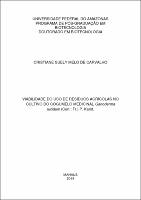| ???jsp.display-item.social.title??? |


|
Please use this identifier to cite or link to this item:
https://tede.ufam.edu.br/handle/tede/4318| ???metadata.dc.type???: | Tese |
| Title: | Viabilidade do uso de resíduos agrícolas no cultivo do cogumelo medicinal Ganoderma lucidum (Curt.: Fr.) P. Karst. |
| ???metadata.dc.creator???: | Carvalho, Cristiane Suely Melo de  |
| ???metadata.dc.contributor.advisor1???: | Andrade, Meire Cristina Nogueira de |
| First advisor-co: | Sales-Campos, Ceci |
| ???metadata.dc.description.resumo???: | Ganoderma lucidum trata-se de um fungo que desperta bastante interesse mundial devido suas inúmeras propriedades medicinais, são relatados principalmente pelo seu poder medicinal, podendo ser utilizados na prevenção e tratamento de diversas doenças incluindo o câncer e AIDS. É um cogumelo que apresenta a capacidade de desenvolver-se em diversos resíduos lignocelulósicos, pelo fato de produzirem enzimas lignocelulolíticas, especializadas em degradar esse tipo de matéria-prima. A espécie G. lucidum, apresenta diversas linhagens distintas, cujas exigências nutricionais que variam em relação ao local de coleta e ao tipo de substrato. Assim, torna-se necessário conhecer os substratos e a situação de cultivo mais adequados as diferentes linhagens de G. lucidum. O objetivo deste estudo foi avaliar a produção de duas linhagens de Ganoderma lucidum em resíduos agrícolas, bem como realizar a caracterização físico-química dos basidiomas obtidos no cultivo. O experimento foi conduzido nas instalações do Módulo de Cogumelos da FCA/UNESP-Botucatu, SP. As linhagens utilizadas foram GLM-09/01 e GLM 10/02. Os resíduos utilizados na cultura foram palha de aveia, palha de feijão, palha de capim braquiária, palha de capim tifton e serragem de eucalipto, todos em duas situações: com (20%) e sem suplementação (0%) de farelo de trigo. Todos os resíduos foram provenientes de despejos da atividade agrícola decorrente do município de Botucatu-SP. Os tratamentos foram realizados em 10 repetições, totalizando 200 pacotes. O cultivo totalizou 95 dias. Avaliou-se a eficiência biológica dos tratamentos e realizou-se a caracterização físico-química dos substratos inicial e residual e também dos basidiomas obtidos. Os valores de EB (%) variaram de 0,0% a 6,7%. Nas analises da composição centesimal dos cogumelos, os parâmetros, proteína bruta, extrato etéreo, cinzas e fibra bruta, os resultados variaram de 8,7% a 13,7%, de 2,0% a 6,7%, de 0,83% a 1,79% e de 38,8% a 54,5% respectivamente. Dos substratos analisados, os que apresentaram maior rendimento foram os formulados à base de palha de braquiária (20%) em ambas as linhagens testadas (GLM-09/01 e GLM 10/02) e palha de feijão (20%) na linhagem GLM 10/02. Os cogumelos apresentaram teores elevados de lipídios, fibras e cinzas e baixo teor de proteínas. |
| Abstract: | Ganoderma lucidum it is a fungus that arouses considerable interest worldwide because on their numerous properties, it is reported mainly for their medicinal power, and it may be used in the prevention and treatment of various diseases including cancer and AIDS. It is a mushroom that has the ability to thrive in a multitude of lignocellulosic wastes, since they produce lignocellulolytic enzymes, specialized to degrade this type of raw material. The G. lucidum species has several distinct lineages, and also nutritional requirements that vary in relation to the collection site and the type of substrate. Therefore, it is necessary to know the substrates, and the situation of the most suitable growing to the different strains of G. lucidum. The aim of this study was to evaluate the production of two strains of Ganoderma lucidum on agricultural waste as well as to perform chemical analyzes of basidiomata obtained in cultivation. The experiment was conducted at the premises of the module Mushrooms FCA / UNESP-Botucatu, SP, in which two strains were used: GLM-09/01 GLM and 10/02 both grown in waste, oat straw, bean straw, straw brachiaria grass Tifton straw and sawdust in two situations: with (20%) and without supplementation (0%) of wheat bran. All the waste came from dumps of agricultural activity resulting from Botucatu-SP. Both treatments were performed in 10 replications, totaling 200 packages. The cultivation of mushrooms totaled 95 days, later we assessed the biological efficiency of the treatments and it was performed and their chemical analysis of initial and residual substrates and basidiomata obtained. EB values (%) ranging from 0.0% to 6.7%. In the chemical analysis of the mushrooms, in the parameters, total protein, ether extract, crude fiber and ash, the results ranged from 8.7% to 13.7%, from 2.0% to 6.7%, 0.83% 1.79% to 38.8% and 54.5% respectively. Thus, it is concluded that from the substrates analyzed, those with the highest income were the base of straw brachiaria 20% in both strains tested (GLM 10/02 and GLM 09/01 and bean straw to 20% GLM on 10/02 line. The mushrooms showed high levels of ether extract, ash and fiber and low protein content. |
| Keywords: | Bromatologia Fungo comestível Eficiência biológica Basidioma Edible fungus Biological efficiency |
| ???metadata.dc.subject.cnpq???: | CIÊNCIAS BIOLÓGICAS |
| Language: | por |
| ???metadata.dc.publisher.country???: | Brasil |
| Publisher: | Universidade Federal do Amazonas |
| ???metadata.dc.publisher.initials???: | UFAM |
| ???metadata.dc.publisher.department???: | Instituto de Ciências Biológicas |
| ???metadata.dc.publisher.program???: | Programa de Pós-Graduação em Biotecnologia |
| Citation: | CARVALHO, Cristiane Suely Melo de. Viabilidade do uso de resíduos agrícolas no cultivo do cogumelo medicinal Ganoderma lucidum (Curt.: Fr.) P. Karst. 2014. 74f. Tese (Doutorado em Biotecnologia) - Universidade Federal do Amazonas, Manaus, 2014. |
| ???metadata.dc.rights???: | Acesso Aberto |
| URI: | http://tede.ufam.edu.br/handle/tede/4318 |
| Issue Date: | 17-Jul-2014 |
| Appears in Collections: | Doutorado em Biotecnologia |
Files in This Item:
| File | Description | Size | Format | |
|---|---|---|---|---|
| Tese - Cristiane Suely Melo de Carvalho.pdf | Tese - Cristiane Suely Melo de Carvalho.pdf | 1.34 MB | Adobe PDF |  Download/Open Preview |
Items in DSpace are protected by copyright, with all rights reserved, unless otherwise indicated.




